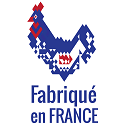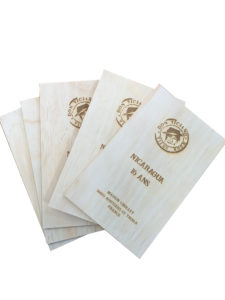The different wood stamping techniques for customizing your communication media Absolu Wood

Wood is a warm, resistant material that adds a touch of authenticity to your communication media. Whether you're looking to personalize corporate gifts, packaging or advertising panels, wood engraving is an original and durable solution for promoting your brand image. There are several techniques for engraving and printing on wood, each offering different results in terms of precision, finesse and aesthetics. In this article, we present the main wood marking techniques, along with their advantages and disadvantages. Discover how to personalize your communication media with elegant and effective wood marking.
Laser engraving on wood
 Laser wood engraving is a marking technique that uses a laser beam to engrave the surface of wood. This technique can be used to create precise, detailed patterns on wood, including logos, images and text. The laser wood engraving process involves the following steps:
Laser wood engraving is a marking technique that uses a laser beam to engrave the surface of wood. This technique can be used to create precise, detailed patterns on wood, including logos, images and text. The laser wood engraving process involves the following steps:
- Preparing the image: The first step is to prepare the image or design you wish to engrave on wood. The image is usually created using computer-aided design (CAD) software.
- Configuring the laser engraving machine: The laser engraving machine must be configured for the appropriate parameters, such as laser speed and power, depending on the density and nature of the wood.
- Laser engraving: The wood is placed on the platform of the laser engraving machine, and the laser is directed at the wood to burn the surface. The laser beam removes the surface of the wood by burning away the areas where the image is to appear, creating a permanent mark.
Laser wood engraving offers high precision and superior image quality compared with other wood marking techniques. It's also fast, clean and precise, enabling you to engrave highly detailed motifs and even reproduce photographic images. Wood laser engraving is therefore an excellent option for personalizing wooden communication media for your company, offering a wide variety of customization possibilities.
Hot stamping on wood
 Hot stamping on wood is another natural stamping technique that is suitable for medium and large production runs, with very competitive unit stamping costs compared to laser engraving. This method uses a hot stamping machine to apply a high-temperature heated imprint to a wooden surface, lightly scorching the surface. The wood hot stamping process involves the following steps:
Hot stamping on wood is another natural stamping technique that is suitable for medium and large production runs, with very competitive unit stamping costs compared to laser engraving. This method uses a hot stamping machine to apply a high-temperature heated imprint to a wooden surface, lightly scorching the surface. The wood hot stamping process involves the following steps:
- Preparing the design: The first step is to create the design you wish to apply to the wood. The design is usually created using computer-aided design (CAD) software.
- Preparing the imprint: like a stamp, the imprint is cut to the size of the design and the wood to be marked.
- Configuration of the hot press: The heating press must be configured for the appropriate parameters, such as temperature and pressure, depending on the density and nature of the wood.
- Applying the impression: the impression is placed on the wood and fixed to the surface using the heated press. The heat and pressure of the press allow the impression to mark the wood, embossing and burning it slightly.
Silk-screen printing on wood

- Screen preparation: A screen is prepared using nylon fabric stretched over a wooden frame. The screen is coated with a photosensitive emulsion.
- Design preparation: The design to be printed is created using computer-aided design (CAD) software and then transferred to transparent film.
- Exposure: The transparent film is placed on the photosensitive emulsion-coated screen, then exposed to UV light. The light-sensitive emulsion hardens where the light reaches the screen, forming the pattern.
- Rinsing: The screen is rinsed with water, and the unexposed parts are washed, creating the necessary openings for the ink to pass through.
- Printing: Wood is placed under the screen, and ink is applied to the screen with a squeegee. The ink passes through the open areas of the screen and is transferred to the wood.
- Drying: After printing, the wood is placed in a drying zone to allow the ink to dry completely.
Silk-screen printing on wood offers great precision and superior image quality, with high resistance to wear and tear.
Four-colour printing on wood

- Surface preparation: The wood surface is prepared by cleaning and sanding if necessary to remove any dirt or imperfections.
- Image preparation: The design or image to be printed is created using computer-aided design (CAD) software.
- Printing: The ink is applied to the wood surface using a UV printer. UV light is used to harden the ink immediately after application, enabling high precision and image quality.
UV wood printing offers high image quality with vivid colors and high resistance to wear and tear, making it an excellent option for wooden marketing products such as business cards, communication media, signage, packaging, etc.

